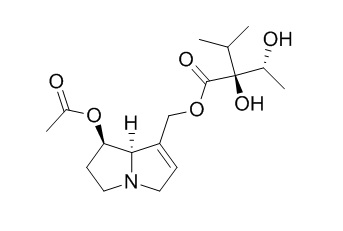7-Acetylintermedine
7-Acetylintermedine, 7-acetyllycopsamine, and symlandine are pyrrolizidine alkaloids, isolated from comfrey, can produce hepatotoxicity in livestock and humans and carcinogenicity in experimental animals.
Inquire / Order:
manager@chemfaces.com
Technical Inquiries:
service@chemfaces.com
Tel:
+86-27-84237783
Fax:
+86-27-84254680
Address:
1 Building, No. 83, CheCheng Rd., Wuhan Economic and Technological Development Zone, Wuhan, Hubei 430056, PRC
Providing storage is as stated on the product vial and the vial is kept tightly sealed, the product can be stored for up to
24 months(2-8C).
Wherever possible, you should prepare and use solutions on the same day. However, if you need to make up stock solutions in advance, we recommend that you store the solution as aliquots in tightly sealed vials at -20C. Generally, these will be useable for up to two weeks. Before use, and prior to opening the vial we recommend that you allow your product to equilibrate to room temperature for at least 1 hour.
Need more advice on solubility, usage and handling? Please email to: service@chemfaces.com
The packaging of the product may have turned upside down during transportation, resulting in the natural compounds adhering to the neck or cap of the vial. take the vial out of its packaging and gently shake to let the compounds fall to the bottom of the vial. for liquid products, centrifuge at 200-500 RPM to gather the liquid at the bottom of the vial. try to avoid loss or contamination during handling.
Wageningen University & Research2018, January 2018
Biomed Pharmacother.2024, 181:117647.
Molecules.2019, 24(10):E1926
J of the Korean Society of Food Science and Nutrition2019, 32(2):148-154
iScience.2024, 4790628.
Inflammation.2022, 45(6):2529-2543.
Int J Mol Sci.2020, 21(19),7070.
Molecules.2021, 26(2):313.
Nat Commun.2023, 14(1):4540.
Molecules.2018, 23(7):E1817
Related and Featured Products
Mutat Res. 1988 Aug;203(4):297-308.
Statistical methods to decide whether mutagenicity test data from Drosophila assays indicate a positive, negative, or inconclusive result.[Pubmed:
3136327]
Two alternative hypotheses are used to distinguish among the possibilities of a positive, inconclusive, or negative result in Drosophila mutagenicity tests. In the null hypothesis one assumes that there is no difference in the mutation frequency between control and treated series. The alternative hypothesis postulates a priori that the treatment results in an increased mutation frequency that is m times the spontaneous frequency.
METHODS AND RESULTS:
To test against the hypotheses, the conditional binomial test according to Kastenbaum and Bowman or the chi 2 test for proportions may be applied. These 2 methods are in principle equivalent. An alternative method which is based on determining confidence limits of observed mutation frequencies also leads to the same conclusions. The practical calculations are formulated and an application is shown with a test example demonstrating the genotoxicity of the pyrrolizidine alkaloid 7-Acetylintermedine in the somatic wing mosaic test. In the Appendix, the calculus for the 3 testing methods is explained with a numerical example.
J Chromatogr A. 2004 Nov 12;1056(1-2):91-7.
On-line structure characterization of pyrrolizidine alkaloids in Onosma stellulatum and Emilia coccinea by liquid chromatography-ion-trap mass spectrometry.[Pubmed:
15595537]
METHODS AND RESULTS:
On-line structure characterization of pyrrolizidine alkaloids in two various plant species (Onosma stellulatum W.K., family Boraginaceae and Emilia coccinea Sims., family Compositae) was performed by a newly elaborated RP-HPLC ion trap MS method with atmospheric pressure chemical ionization (APCI) interface. Different PAs (N-oxides, free bases, otonecine alkaloids) isolated were separated on Waters XTerra C18 column using a gradient elution. The combination of a CE-SPE with multiple isolation and fragmentation steps for specific masses in ion trap MS detector enabled fast and sensitive analysis of various types of PAs (N-oxides and free bases). In O. stellulatum, spectra 12 various types of structures (13 different alkaloids) have been determined for the first time: leptanthine-N-oxide, lycopsamine-N-oxide, heliospathuline, lycopsamine, trachelanthamine-N-oxide, dihydroechinatine, leptanthine, heliospathuline-N-oxide, 7-Acetylintermedine, uplandicine, echimidine and echimidine-N-oxide.
CONCLUSIONS:
In E. coccinea, the following types of PAs were found: platyphylline-N-oxide, platyphylline (three stereoisomers with the same MS(n) spectrum), ligularidine, neoligularidine, neosenkirkine and also previously reported senkirkine. The method elaborated can be applied in the structural analysis of PAs in newly examined plant materials or food products but further analysis is needed to determine the stereochemistry in details.
J Toxicol Environ Health B Crit Rev. 2010 Oct;13(7-8):509-26.
Metabolism, genotoxicity, and carcinogenicity of comfrey.[Pubmed:
21170807]
Comfrey has been consumed by humans as a vegetable and a tea and used as an herbal medicine for more than 2000 years. Comfrey, however, produces hepatotoxicity in livestock and humans and carcinogenicity in experimental animals.
METHODS AND RESULTS:
Comfrey contains as many as 14 pyrrolizidine alkaloids (PA), including 7-Acetylintermedine, 7-acetyllycopsamine, echimidine, intermedine, lasiocarpine, lycopsamine, myoscorpine, symlandine, symphytine, and symviridine. The mechanisms underlying comfrey-induced genotoxicity and carcinogenicity are still not fully understood. The available evidence suggests that the active metabolites of PA in comfrey interact with DNA in liver endothelial cells and hepatocytes, resulting in DNA damage, mutation induction, and cancer development. Genotoxicities attributed to comfrey and riddelliine (a representative genotoxic PA and a proven rodent mutagen and carcinogen) are discussed in this review. Both of these compounds induced similar profiles of 6,7-dihydro-7-hydroxy-1-hydroxymethyl-5H-pyrrolizine (DHP)-derived DNA adducts and similar mutation spectra. Further, the two agents share common mechanisms of drug metabolism and carcinogenesis.
CONCLUSIONS:
Overall, comfrey is mutagenic in liver, and PA contained in comfrey appear to be responsible for comfrey-induced toxicity and tumor induction.



